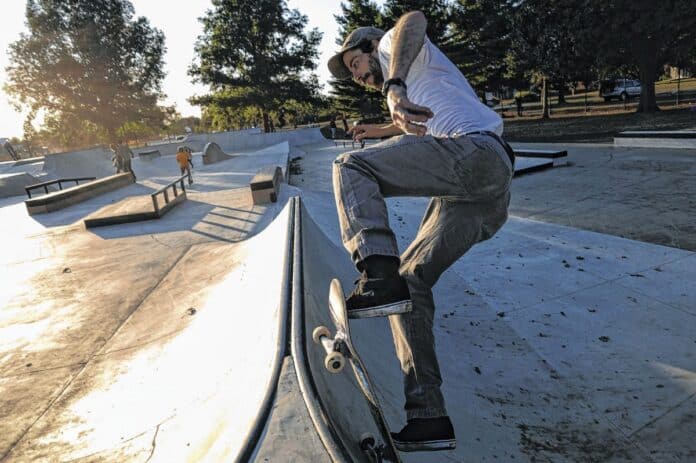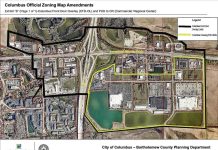
In a city where schools, churches, libraries and fire stations are designed by world-renowned architects, it only makes sense that Columbus’ skate park at Indiana Avenue and Marr Road is of an international design pedigree.
The Jolie Crider Memorial Skate Park was built in Clifty Park in 1999, the result of a dream that a group of skaters had to build a skate park in the city. The park is named in memory of Columbus North High School freshman Jolie Crider, who died at age 14 from bacterial meningitis on May 7, 1994.
The skate park has since been a city attraction for thousands of local skaters who find thrills in shredding rails and flipping in the air.
But with 20 years of use comes considerable damage and wear and tear.
[sc:text-divider text-divider-title=”Story continues below gallery” ]Click here to purchase photos from this gallery
Chip Orben, Columbus Parks Foundation president, said the skate park had been identified as a project that needed to done. The material in the former skate park had become so worn out that maintaining it was becoming an even greater issue.
When faced with the choice between renovation and rebuild, the answer was clear to the city. In comes the Jolie Crider Memorial Skate Park 2.0.
In an online community survey, a total of 66.67% of more than 200 respondents indicated that skateboarding, skating, BMX biking or using a scooter in the Jolie Crider Memorial Skate Park was their primary source of exercise, the foundation reported.
“It offered us an opportunity to continue to address a need people were asking — an enhanced skate park arena that was a little bit safer than the old one,” Orben said. “What we know today versus what we knew 20 years ago has dramatically changed.”
The city brought on board Janne Saario, a Finnish skater-turned-architect, to design the new durable concrete skate park — Jolie Crider 2.0. According to an article by the New York Times, Jonathan Nesci, a designer who lives in Columbus and is the father of a skater, emailed Saario after listening to “The Pool and the Stream,” a 2017 episode of the podcast “99 Percent Invisible” that featured Saario.
“Mr. Nesci eventually gave Mr. Saario one of his mirror-polished side tables in return for a conceptual design,” according to the Times article.
Saario was selected with “an eye toward the final design as a tribute to the architectural and design heritage of Columbus while providing a safe, healthy place for skating and other alternative sports,” according to the foundation.
This project is Saario’s first skate park to debut in the United States. Saario has developed several skate parks in Europe.
“It really ties in with existing architecture in Columbus and not just existing architecture but the finished architecture,” said Stacy Findley, the former parks department’s project and resource development director. “We haven’t really had that in a while, so it’s nice to know as a community that we’re continuing to invest.”
Hunger SkateParks, a Bloomington-based skate park contractor, signed on to build the nearly $400,000, 14,000-square-foot project. Funding for the project has come through a combination of private donations, parks and recreational capital monies and several grants, including support from the city, Heritage Fund — the Community Foundation of Bartholomew County, the Columbus Parks Foundation and local donors, Orben said.
“It was a collaboration with several different groups to put together a design that was first in class,” Orben said. “We’re blessed to live in a community that is diverse in what they enjoy to do. We’re glad to be able to provide assistance in raising those funds and providing this new skate park for all to enjoy.”
The park is designed into three sections that flow together seamlessly, Hunger SkateParks officials said.
Using about 2,500 square-feet of the former skate park’s wood slab, the entrance section is also equipped with all new flat-ground features flanked with a new bank to cub and quarter pipe, the developer said.
The middle section had mixed transitions and street features, including a rainbow rail and quarter, a kong wall, jumps, bank to rails, hubbas and ledges with three elevation changes. The third section is a long ditch-like bowl with two minis of different heights, extension and a large transfer into a transition hip area that flows riders back into the other two sections of the park.
City officials have not yet scheduled a grand opening for the skate park, although skaters have been using the facility at random times since completion.
The skate park is closed through Saturday to allow crews time to finish construction work, and is scheduled to reopen Sunday, according to the Columbus Parks and Recreation Department.
[sc:pullout-title pullout-title=”Where to learn more” ][sc:pullout-text-begin]
To learn more about the Jolie Crider Memorial Skate Park, visit columbusparkfoundation.org/projects.
[sc:pullout-text-end][sc:pullout-title pullout-title=”How to get there” ][sc:pullout-text-begin]
The Jolie Crider Memorial Skate Park 2.0 is located at Indiana Avenue and Marr Road in Clifty Park.
The skate park is closed to the public through Sunday to allow crews to wrap up the work that must be completed prior to the official re-opening of the revamped skate park.
[sc:pullout-text-end][sc:pullout-title pullout-title=”About the designer” ][sc:pullout-text-begin]
Janne Saario is a professional skateboarder-turned-architect from Helinski, Finland. Following his career as a professional skater, he began to focus his efforts on designing surroundings for skateboarding.
This project is Saario’s first skate park to debut in the United States. Saario has developed several skate parks in Europe.
To learn more, visit jannesaario.com.
[sc:pullout-text-end]




